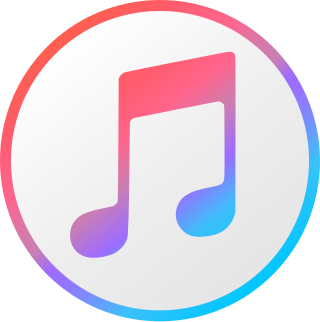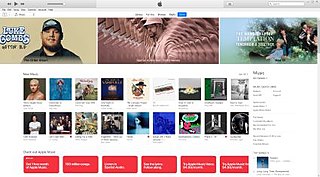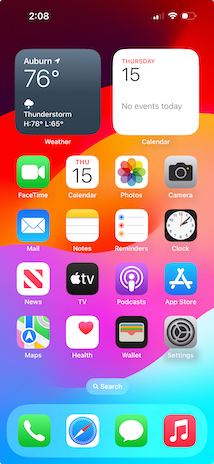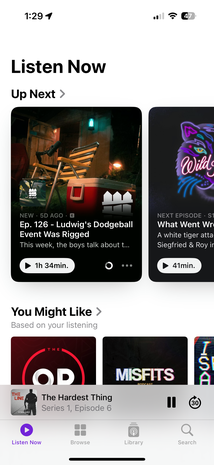Books
| | This section is empty. You can help by adding to it. (September 2023) |
FairPlay is a family of digital rights management (DRM) technologies developed by Apple Inc. for protecting videos, books and apps and historically for music. [1]
The initial version of FairPlay was created to protect music on the iTunes Store, and is the only version of FairPlay that is no longer actively used. [2]
FairPlay is built into the MP4 multimedia file format as an encrypted AAC audio layer. FairPlay-protected files are regular MP4 container files with an encrypted AAC audio layer. The layer is encrypted using the AES algorithm. The master key required to decrypt the audio layer is also stored in encrypted form in the MP4 container file. The key required to decrypt the master key is called the "user key". [3] [4] When a user registers a new computer with iTunes, the device requests authorization from Apple's servers, thereby gaining a user key. Upon attempting to play a file, the master key stored within the file is then matched to the user key, and if successful, allows playing. [4] FairPlay allows music to be synchronized to an unlimited number of iPods and tracks to be burned to an unlimited number of CDs, though a given playlist can only be burned 7 times without being modified (a limitation which can be circumvented by changing a song's placement). Playback is limited to five computers which were authorized through iTunes; [5] a computer can be deauthorized and another authorized in its place. [6] Before April 2004, the limits were ten playlist burns, and three computers; Apple reduced the playlist limit to seven due to demands from record labels. [7]
In January 2005, an iTunes customer filed a lawsuit against Apple, alleging that the company broke antitrust laws by using FairPlay with iTunes in a way that purchased music would work only with the company's own music player, the iPod, freezing out competitors. [8] In March 2011, Bloomberg reported that Apple's then-CEO Steve Jobs would be required to provide testimony through a deposition. [9] In May 2012, the case was changed into a class action lawsuit. [10] [8] Around the same time, the main antitrust allegation was changed to cover the belief that Apple had deliberately updated the iTunes software with security patches in a way that prevented synchronization compatibility with competing music stores. [11] All iPod owners who had purchased their device between September 12, 2006, and March 31, 2009, were included in the class action lawsuit, unless they opted out. [10] [8] In December 2014, Apple went to trial against the claims raised, with the opposing party's plaintiff lawyers seeking $350 million in damages for nearly eight million affected customers. [12] [13] A few weeks later, the case was closed, with the jury deciding in Apple's favor, citing a then-new version of iTunes as being a "genuine product improvement". [14] [15]
The restrictions imposed by FairPlay, mainly limited device compatibility, have sparked criticism, with a lawsuit alleging antitrust violation that was eventually closed in Apple's favor, and various successful efforts to remove the DRM protection from files, with Apple continually updating its software to counteract such projects.
After the introduction of the FairPlay system, multiple parties have attempted and succeeded to circumvent or remove the encryption of FairPlay-protected files. In October 2006, Jon Johansen announced he had reverse engineered FairPlay and would start to license the technology to companies wanting their media to play on Apple's devices. [16] [17] Various media publications have written about DRM removal software, [18] [19] though Apple has continually made efforts in updating its software to counteract these options, resulting in upgraded DRM systems and discontinued DRM removal software. [20] [21]
In July 2004, RealNetworks introduced its Harmony technology. The Harmony technology was built into the company's RealPlayer and allowed users of the RealPlayer Music Store to play their songs on the iPod. [22] [23] In a press release, RealNetworks argued that Harmony was a boon to consumers that "frees" them "from the limitation of being locked into a specific portable device when they buy digital music." [24] In response, Apple issued a statement: [25] [26]
We are stunned that RealNetworks has adopted the tactics and ethics of a hacker to break into the iPod, and we are investigating the implications of their actions under the DMCA and other laws.
RealNetworks launched an Internet petition titled "Hey Apple! Don't break my iPod", encouraging iPod users to sign up to support Real's action. The petition backfired, with comments criticizing Real's tactics, though some commentators also supported it. [27] At the end of 2004, Apple had updated its software in a way that broke the Harmony technology, prompting RealNetworks to promise a then-upcoming fix. [28]
In August 2005, an SEC filing by RealNetworks disclosed that continued use of the Harmony technology put themselves at considerable risk because of the possibility of a lawsuit from Apple, which would be expensive to defend against, even if the court agreed that the technology was legal. Additionally, the possibility that Apple could change its technology to purposefully "break" Harmony's function raised the possibility that Real's business could be harmed. [29] [30]
Hymn (which stands for Hear Your Music aNywhere) was an open-source tool that allowed users to remove the FairPlay DRM of music bought from the iTunes Store. [31] [32] [33] It was later supplanted by QTFairUse6. [34] The Hymn project later shut down after a cease and desist from Apple. [35]
On February 6, 2007, Steve Jobs, then-CEO of Apple, published an open letter titled "Thoughts on Music" on the Apple website, calling on the "big four" record labels to sell their music without DRM technology. According to the letter, Apple did not want to use DRM, but was forced to by the four major music labels, with whom Apple has license agreements for iTunes sales of music. Jobs' main points were: [36] [37]
Although the open letter initially caused mixed industry reactions, Apple signed a deal with a major record label the following month to offer iTunes customers a purchase option for a higher-quality, DRM-free version of the label's tracks.
Jobs' letter was met with mixed reactions. Bloomberg highlighted several viewpoints. David Pakman, President of non-DRM music retailer eMusic, agreed with Jobs, stating that "consumers prefer a world where the media they purchase is playable on any device, regardless of its manufacturer, and is not burdened by arbitrary usage restrictions. DRM only serves to restrict consumer choice, prevents a larger digital music market from emerging, and often makes consumers unwitting accomplices to the ambitions of technology companies". Mike Bebel, CEO of music subscription service Ruckus, explained his view that the letter was an effort to shift focus, saying that "This is a way for Steve Jobs to take the heat off the fact that he won't open up his proprietary DRM. ... The labels have every right to protect their content, and I don't see it as a vow of good partnership to turn the tables on the labels and tell them they should just get rid of all DRM... He is trying to spin the controversy." An anonymous music label executive said that "it's ironic that the guy who has the most successful example of DRM at every step of the process, the one where people bought boatloads of music last Christmas, is suddenly changing his tune". [38] In an article from The New York Times , Ted Cohen, managing partner at TAG Strategic, commented that the change could be "a clear win for the consumer electronics device world, but a potential disaster for the content companies". The Recording Industry Association of America put particular emphasis on Jobs' self-rejected idea about licensing its FairPlay technology to other companies, saying that such licensing would be "a welcome breakthrough and would be a real victory for fans, artists and labels". [39]
In April 2007, Apple and the record label EMI announced that iTunes Store would begin offering, as an additional higher purchasing option, tracks from EMI's catalog encoded as 256 kbit/s AAC without FairPlay or any other DRM. [40] In January 2009, Apple announced that the entire iTunes Store music catalog would become available in the higher-quality, DRM-free format, after reaching agreements with all the major record labels as well as "thousands of independent labels". [41] [42] [43] Apple Music, Apple's subscription-based music streaming service launched on June 30, 2015, [44] uses the DRM technology. [45]
FairPlay Streaming (FPS) protects video transferred over HTTP Live Streaming (HLS) on iOS devices, in Apple TV, and in Safari on macOS. The content provider's server first delivers video to the client application encrypted with the content key using the AES cipher. The application then requests a session key from the device's FairPlay module. The session key is a randomly generated nonce which is RSA encrypted with the provider's public key and delivered to the provider's server. The provider's server encrypts the content key using the session key and delivers it to the FairPlay module, which decrypts it and uses it to decrypt the content for playback. [46]
On iOS and Apple TV, the session key handling and content decryption is done in the kernel, while on macOS it is done using Safari's FairPlay Content Decryption Module.
| | This section is empty. You can help by adding to it. (September 2023) |
Apps downloaded from the App Store are protected and code signed using a variant of FairPlay DRM for apps. FairPlay DRM creates a public/private key pair when a device is registered with an iCloud account, and encrypting app encryption keys using the "public" key (which is kept on Apple's servers) in order to decrypt them on the device using the "private" key. [47] [ better source needed ]
In July 2012, an issue with the creation of FairPlay-protected apps caused binaries to become corrupt and stop working. [48]
A flaw allowing a form of man-in-the-middle attack can be used to install malware when an iOS device is connected to a computer. [49]

The iPod is a discontinued series of portable media players and multi-purpose mobile devices designed and marketed by Apple Inc. The first version was released on November 10, 2001, about 8+1⁄2 months after the Macintosh version of iTunes was released. Apple sold an estimated 450 million iPod products as of 2022. Apple discontinued the iPod product line on May 10, 2022. At over 20 years, the iPod brand is the oldest to be discontinued by Apple.
In economics, vendor lock-in, also known as proprietary lock-in or customer lock-in, makes a customer dependent on a vendor for products, unable to use another vendor without substantial switching costs.

iTunes is a software program that acts as a media player, media library, mobile device management utility, and the client app for the iTunes Store. Developed by Apple Inc., it is used to purchase, play, download and organize digital multimedia on personal computers running the macOS and Windows operating systems, and can be used to rip songs from CDs as well as playing content from dynamic, smart playlists. It includes options for sound optimization and wirelessly sharing iTunes libraries.

The iTunes Store is a digital media store operated by Apple Inc. It opened on April 28, 2003, as a result of Steve Jobs' push to open a digital marketplace for music. As of April 2020, iTunes offered 60 million songs, 2.2 million apps, 25,000 TV shows, and 65,000 films. When it opened, it was the only legal digital catalog of music to offer songs from all five major record labels.
The Apple Lossless Audio Codec (ALAC), also known as Apple Lossless, or Apple Lossless Encoder (ALE), is an audio coding format, and its reference audio codec implementation, developed by Apple Inc. for lossless data compression of digital music. After initially keeping it proprietary from its inception in 2004, in late 2011 Apple made the codec available open source and royalty-free. Traditionally, Apple has referred to the codec as Apple Lossless, though more recently it has begun to use the abbreviated term ALAC when referring to the codec.
Mobile music is music which can be transported, or in other words, mobile. The term itself is a bit ambiguous.

The iTunes media platform was first released by Apple in 2001 as a simple music player for Mac computers. Over time, iTunes developed into a sophisticated multimedia content manager, hardware synchronization manager and e-commerce platform. iTunes was finally discontinued for new Mac computers in 2019, but is still available and supported for Macs running older operating systems and for Windows computers to ensure updated compatibility for syncing with new releases of iOS devices.
The open music model is an economic and technological framework for the recording industry based on research conducted at the Massachusetts Institute of Technology. It predicts that the playback of prerecorded music will be regarded as a service rather than as individually sold products, and that the only system for the digital distribution of music that will be viable against piracy is a subscription-based system supporting file sharing and free of digital rights management. The research also indicated that US$9 per month for unlimited use would be the market clearing price at that time, but recommended $5 per month as the long-term optimal price.
The multinational technology corporation Apple Inc. has been a participant in various legal proceedings and claims since it began operation and, like its competitors and peers, engages in litigation in its normal course of business for a variety of reasons. In particular, Apple is known for and promotes itself as actively and aggressively enforcing its intellectual property interests. From the 1980s to the present, Apple has been plaintiff or defendant in civil actions in the United States and other countries. Some of these actions have determined significant case law for the information technology industry and many have captured the attention of the public and media. Apple's litigation generally involves intellectual property disputes, but the company has also been a party in lawsuits that include antitrust claims, consumer actions, commercial unfair trade practice suits, defamation claims, and corporate espionage, among other matters.

Defective by Design (DBD) is a grassroots anti-digital rights management (DRM) initiative by the Free Software Foundation (FSF) and CivicActions. Launched in 2006, DBD believes that DRM makes technology deliberately defective, negatively affects digital freedoms, and is "a threat to innovation in media, the privacy of readers, and freedom for computer users." The initiative regularly campaigns against the use of DRM by the media industry and software industry to increase awareness of the anti-DRM movement and pressure industries into no longer using DRM. They are known for their use of hazmat suits in their demonstrations.

The iPod Touch is a discontinued line of iOS-based mobile devices designed and formerly marketed by Apple Inc. with a touchscreen-controlled user interface. As with other iPod models, the iPod Touch can be used as a portable media player and a handheld gaming device, but can also be used as a digital camera, a web browser, for email and messaging. It is nearly identical in design to the iPhone, and can run most iPhone third-party apps from the App Store, but it connects to the Internet only through Wi-Fi and uses no cellular network data, as it lacks a cellular modem.

iOS is a mobile operating system developed by Apple Inc. exclusively for its smartphones. It was unveiled in January 2007 for the first-generation iPhone, launched in June 2007.
Digital rights management (DRM) is the management of legal access to digital content. Various tools or technological protection measures (TPM), such as access control technologies, can restrict the use of proprietary hardware and copyrighted works. DRM technologies govern the use, modification and distribution of copyrighted works and of systems that enforce these policies within devices. DRM technologies include licensing agreements and encryption.

RealNetworks LLC is a provider of artificial intelligence and computer vision based products. RealNetworks was a pioneer in Internet streaming software and services. They are based in Seattle, Washington, United States. The company also provides subscription-based online entertainment services and mobile entertainment and messaging services.

AirPlay is a proprietary wireless communication protocol stack/suite developed by Apple Inc. that allows streaming between devices of audio, video, device screens, and photos, together with related metadata. Originally implemented only in Apple's software and devices, it was called AirTunes and used for audio only. Apple has since licensed the AirPlay protocol stack as a third-party software component technology to manufacturers that build products compatible with Apple's devices.
Didiom was a digital media company that specialized in the development of streaming media applications and wireless content delivery platforms. Built on peer-to-peer placeshifting technology, the company's flagship product allowed customers to stream their home computer's audio collection to their phone wirelessly, eliminating the need for data cables and memory cards. With two million songs under its management, Didiom previously launched an on-device music store that allowed customers to name their own prices for music downloads. In February 2011, Didiom was acquired by SnapOne, Inc.

iCloud is a cloud service developed by Apple Inc. Launched on October 12, 2011, iCloud enables users to store and sync data across devices, including Apple Mail, Apple Calendar, Apple Photos, Apple Notes, contacts, settings, backups, and files, to collaborate with other users, and track assets through Find My. It is built into iOS, iPadOS, watchOS, tvOS, macOS, and visionOS. iCloud may additionally be accessed through a limited web interface and Windows application.
The following outline of Apple Inc. is a topical guide to the products, history, retail stores, corporate acquisitions, and personnel under the purview of the American multinational corporation Apple Inc.

Apple Podcasts is an audio streaming service and media player application developed by Apple Inc. for playing podcasts. Apple began supporting podcasts with iTunes 4.9 released in June 2005 and launched its first standalone mobile app in 2012. The app was later pre-installed with iOS beginning October 2014. The Apple Podcasts directory features more than two million shows. Apple Podcasts is available on iOS, iPadOS, macOS, watchOS, tvOS, CarPlay, Microsoft Windows operating systems, and on Amazon Alexa devices.